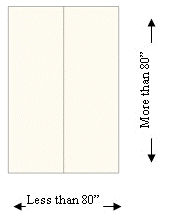BACKING: There are many charts for calculating backing available in quilting resource books; however, I will give you my rule of thumb.
If the longest side of your quilt is 80" or less, you can piece your quilt back with a horizontal seam.
- Add 6" to the width of your quilt top.
- Multiply this number x 2 = Linear Inches Needed
- Linear Inches Needed / 36" = Total Yardage Required
If your quilt top is longer than 80", but no wider than 80", you can piece your quilt back with a vertical seam.
- Add 6" to the length of your quilt top.
- Multiply this number x 2 = Linear Inches Needed
- Linear Inches Needed / 36" = Total Yardage Required
If both the length and width of your quilt top is greater than 80", you will need to piece your back with 3 panels.
- Add 6" to the width of your quilt top.
- Multiply this number x 3 = Linear Inches Needed
- Linear Inches Needed / 36" = Total Yardage Required
BINDING: The formula for calculating binding is a simple 4-step process, but you do need to decide how wide you wish to cut your binding before doing the math. This is the calculation for cross-grain (WOF) binding. If you want to make bias binding, I suggest you purchase 1 yard to minimize the number of seams required to piece your binding.
1. (Length + Width of Quilt) x 2 = # Linear Inches of Binding Required
2. # Linear Inches of Binding Required / 40" usable WOF = # Strips Needed
3. # Strips Needed x Binding Width = # Linear Inches of Fabric Needed
4. # Linear Inches of Fabric Needed / 36" per yard = Yardage Needed (rounded up)
For example, if I have a quilt that is 72" x 80", and I cut my binding 2-1/4" wide, here are the steps I would follow:
- (72" + 80") x 2 = 304" of linear binding required
- 304" / 40" = 7.6 strips needed (rounded up to 8) If your calculation is very close to being a whole number before rounding up (like 5.8 or 6.9), I recommend adding one more strip to your count. I'd rather have too much binding than not enough!
- 8 strips x 2-1/4" wide = 18" of fabric needed
- 18" of fabric needed / 36" per yard = 1/2 yard of fabric
I hope you have learned something from these last 4 posts. I know it's a lot of information, but it's kind of like undergarments. You need a good foundation for the the rest of it to look good!
Next week: Buying a Sewing Machine!




Thanks so much for all of the Math information, I can't wait to actually use it for a project. Really looking forward to the sewing machine tutorial, definitely in the market in the next year.
ReplyDelete